Effect of Microstructure on High Cycle Fatigue Behavior of 211Z.X-T6 Aluminum Alloy
Abstract
:1. Introduction
2. Materials and Methods
3. Results and Discussion
3.1. Microstructure and Mechanical Properties
3.1.1. Matrix Microstructure
3.1.2. Second Phase
3.1.3. Mechanical Properties of 211Z.X Alloy before Fatigue
3.2. High Cycle Fatigue Performance of 211Z.X Alloy
3.3. Fatigue Fracture Analysis of 211Z.X Alloy
3.3.1. Fatigue Crack Initiation Behavior of 211Z.X Alloy with Different Microstructures
3.3.2. Fatigue Crack Propagation Behavior of 211Z.X Alloy with Different Microstructures
3.3.3. Effect of Microstructure on HCF Deformation of 211Z.X Alloy
3.3.4. Relationship between the Size of the Second Phase, Grain Size, and Strength of 211Z.X Alloy
4. Conclusions
Author Contributions
Funding
Institutional Review Board Statement
Informed Consent Statement
Data Availability Statement
Conflicts of Interest
References
- Rioja, R.J. Fabrication Methods to Manufacture Isotropic Al-Li Alloys and Products for Space and Aerospace Applications. Mater. Sci. Eng. A 1998, 257, 100–107. [Google Scholar] [CrossRef]
- Miller, W.S.; Zhuang, L.; Bottema, J.; Wittebrood, A.J.; De Smet, P.; Haszler, A.; Vieregge, A. Recent Development in Aluminium Alloys for the Automotive Industry. Mater. Sci. Eng. A 2000, 280, 37–49. [Google Scholar] [CrossRef]
- Dursun, T.; Soutis, C. Recent Developments in Advanced Aircraft Aluminium Alloys. Mater. Des. (1980–2015) 2014, 56, 862–871. [Google Scholar] [CrossRef]
- Hirsch, J.; Al-Samman, T. Superior Light Metals by Texture Engineering: Optimized Aluminum and Magnesium Alloys for Automotive Applications. Acta Mater. 2013, 61, 818–843. [Google Scholar] [CrossRef]
- Hattori, C.S.; Almeida, G.F.C.; Gonçalves, R.L.P.; Santos, R.G.; Souza, R.C.; Da Silva, W.C.; Cunali, J.R.C.; Couto, A.A. Microstructure and Fatigue Properties of Extruded Aluminum Alloys 7046 and 7108 for Automotive Applications. J. Mater. Res. Technol. 2021, 14, 2970–2981. [Google Scholar] [CrossRef]
- Zhao, Z.; Liu, L.; Chen, Z. Co-Strengthening Contribution of δ′ and T1 Precipitates in Al-Li Alloys 2090 and 2090 + Ce. Rare Metals 2006, 25, 197–201. [Google Scholar] [CrossRef]
- Itoh, G.; Kanno, M.; Hagiwara, T.; Sakamoto, T. Embrittlement in an Age-Hardened 2091 Aluminum Alloy by Exposure at Elevated Temperatures Below the Aging Temperature. Acta Mater. 1999, 47, 3799–3809. [Google Scholar] [CrossRef]
- Ohsaki, S.; Kobayashi, K.; Iino, M.; Sakamoto, T. Fracture Toughness and Stress Corrosion Cracking of Aluminium-Lithium Alloys 2090 and 2091. Corros. Sci. 1996, 38, 793–802. [Google Scholar] [CrossRef]
- Shen, Y.Z.; Oh, K.H.; Lee, D.N. Serrated Flow Behavior in 2090 Al–Li Alloy Influenced by Texture and Microstructure. Mater. Sci. Eng. A 2006, 435–436, 343–354. [Google Scholar] [CrossRef]
- Pantelakis, S.G.; Daglaras, P.G.; Apostolopoulos, C.A. Tensile and Energy Density Properties of 2024, 6013, 8090 and 2091 Aircraft Aluminum Alloy After Corrosion Exposure. Theor. Appl. Fract. Mec. 2000, 33, 117–134. [Google Scholar] [CrossRef]
- Biswas, A.; Siegel, D.J.; Wolverton, C.; Seidman, D.N. Precipitates in Al–Cu Alloys Revisited: Atom-Probe Tomographic Experiments and First-Principles Calculations of Compositional Evolution and Interfacial Segregation. Acta Mater. 2011, 59, 6187–6204. [Google Scholar] [CrossRef]
- Knap, V.; Švecová, I.; Tillová, E.; Kuchariková, L. Influence of Iron Content on SDAS Factor, Al5FeSi Intermetallic Phases and Porosity of the Secondary Aluminum Alloy AlSi7Mg0.6 Used in the Automotive Industry. Transp. Res. Procedia 2021, 55, 814–820. [Google Scholar] [CrossRef]
- Fu, J.; Cui, K. Effect of Mn Content on the Microstructure and Corrosion Resistance of Al-Cu-Mg-Mn Alloys. J. Alloys Compd. 2022, 896, 162903. [Google Scholar] [CrossRef]
- Mei, L.; Chen, X.P.; Wang, C.; Xie, J.; Liu, Q. Good Combination of Strength and Corrosion Resistance in an Al-Cu-Mg Alloy Processed by a Short-Cycled Thermomechanical Treatment. Mater. Charact. 2021, 181, 111469. [Google Scholar] [CrossRef]
- Hu, Z.; Fan, C.; Shen, T.; Ou, L.; Dai, N.; Wang, L. Effect of Aging Treatment on Evolution of S′ Phase in Rapid Cold Punched Al−Cu−Mg Alloy. T. Nonferr. Metal. Soc. 2021, 31, 1930–1938. [Google Scholar] [CrossRef]
- Wang, Y.; Lin, X.; Kang, N.; Wang, Z.; Liu, Y.; Huang, W. Influence of Post-Heat Treatment on the Microstructure and Mechanical Properties of Al-Cu-Mg-Zr Alloy Manufactured by Selective Laser Melting. J. Mater. Sci. Technol. 2022, 111, 35–48. [Google Scholar] [CrossRef]
- Duan, S.Y.; Huang, L.K.; Yang, S.H.; Zhou, Z.; Song, S.J.; Yang, X.B.; Chen, Y.Z.; Li, Y.J.; Liu, G.; Liu, F. Uncovering the Origin of Enhanced Strengthening in Li-added Al–Cu–Mg Alloys. Mater. Sci. Eng. A 2021, 827, 142079. [Google Scholar] [CrossRef]
- Yang, R.; Feng, Z.; Huang, T.; Wu, G.; Godfrey, A.; Huang, X. Unprecedented Age-Hardening and its Structural Requirement in a Severely Deformed Al-Cu-Mg Alloy. Scripta Mater. 2022, 206, 114240. [Google Scholar] [CrossRef]
- Mao, X.; Yi, Y.; He, H.; Huang, S.; Guo, W. Second Phase Particles and Mechanical Properties of 2219 Aluminum Alloys Processed by an Improved Ring Manufacturing Process. Mater. Sci. Eng. A 2020, 781, 139226. [Google Scholar] [CrossRef]
- Wang, T.; Huang, Y.; Ma, Y.; Wu, L.; Yan, H.; Liu, C.; Liu, Y.; Liu, B.; Liu, W. Microstructure and Mechanical Properties of Powder Metallurgy 2024 Aluminum Alloy During Cold Rolling. J. Mater. Res. Technol. 2021, 15, 3337–3348. [Google Scholar] [CrossRef]
- Pouraliakbar, H.; Firooz, S.; Jandaghi, M.R.; Khalaj, G.; Amirafshar, A. Combined Effect of Heat Treatment and Rolling on Pre-Strained and SPDed Aluminum Sheet. Mater. Sci. Eng. A 2014, 612, 371–379. [Google Scholar] [CrossRef]
- Ashkenazi, D. How Aluminum Changed the World: A Metallurgical Revolution through Technological and Cultural Perspectives. Technol. Forecast. Soc. Chang. 2019, 143, 101–113. [Google Scholar] [CrossRef]
- Pirhayati, P.; Jamshidi Aval, H. Effect of Post-Heat Treatment on Friction Surfaced Al-Cu-Mg Alloy Coating Containing Ag. Surf. Coat. Technol. 2020, 397, 125984. [Google Scholar] [CrossRef]
- Chaowen, H.; Mingpan, W.; Yang, M.; Yilong, L.; Xin, W.; Fei, Z. Effect of solution process on microstructure and properties of high strength and toughness 211Z.X aluminum alloy. Rare Met. 2019, 43, 816–823. (In Chinese) [Google Scholar]
- Chaowen, H.; Yilong, L.; Yang, M.; Pingwei, X.; Xiang, L.; Yu, L. Fatigue characteristics of High strength and heat resistant 211Z.X aluminum alloy. Heat Treat. Met. 2013, 38, 43–47. (In Chinese) [Google Scholar]
- Mao, X.; Yi, Y.; Huang, S.; Guo, W.; He, H.; Que, J. Effects of Warm Saddle Forging Deformation on the Reduction of Second-Phase Particles and Control of the Three-Dimensional Mechanical Properties of 2219 Aluminum Alloy Rings. Mater. Sci. Eng. A 2021, 804, 140737. [Google Scholar] [CrossRef]
- Wang, B.; Yi, Y.; He, H.; Huang, S. Effects of Deformation Temperature on Second-Phase Particles and Mechanical Properties of Multidirectionally-Forged 2A14 Aluminum Alloy. J. Alloys Compd. 2021, 871, 159459. [Google Scholar] [CrossRef]
- Ma, M.; Li, Z.; Qiu, W.; Xiao, Z.; Zhao, Z.; Jiang, Y. Microstructure and Properties of Cu–Mg-Ca Alloy Processed by Equal Channel Angular Pressing. J. Alloys Compd. 2019, 788, 50–60. [Google Scholar] [CrossRef]
- Zha, M.; Li, Y.; Mathiesen, R.H.; Bjørge, R.; Roven, H.J. Microstructure Evolution and Mechanical Behavior of a Binary Al–7Mg Alloy Processed by Equal-Channel Angular Pressing. Acta Mater. 2015, 84, 42–54. [Google Scholar] [CrossRef]
- Rao, P.N.; Singh, D.; Jayaganthan, R. Mechanical Properties and Microstructural Evolution of Al 6061 Alloy Processed by Multidirectional Forging at Liquid Nitrogen Temperature. Mater. Des. (1980–2015) 2014, 56, 97–104. [Google Scholar] [CrossRef]
- Pollak, R.; Palazotto, A.; Nicholas, T. A Simulation-Based Investigation of the Staircase Method for Fatigue Strength Testing. Mech. Mater. 2005, 38, 1170–1181. [Google Scholar] [CrossRef]
- Paolino, D.S.; Tridello, A.; Chiandussi, G.; Rossetto, M. Effect of Defect Size On P-S-N Curves in Very-High-Cycle Fatigue. Procedia Struct. Integr. 2017, 7, 335–342. [Google Scholar] [CrossRef]
- Zheng, X.L.; Lü, B.; Jiang, H. Determination of Probability Distribution of Fatigue Strength and Expressions of P-S-N Curves. Eng. Fract. Mech. 1995, 50, 483–491. [Google Scholar] [CrossRef]
- Huang, C.; Zhao, Y.; Xin, S.; Tan, C.; Zhou, W.; Li, Q.; Zeng, W. Effect of Microstructure on High Cycle Fatigue Behavior of Ti–5Al–5Mo–5V–3Cr–1Zr Titanium Alloy. Int. J. Fatigue 2017, 94, 30–40. [Google Scholar] [CrossRef]
- Sajadifar, S.V.; Scharifi, E.; Wegener, T.; Krochmal, M.; Lotz, S.; Steinhoff, K.; Niendorf, T. On the Low-Cycle Fatigue Behavior of Thermo-Mechanically Processed High-Strength Aluminum Alloys. Int. J. Fatigue 2022, 156, 106676. [Google Scholar] [CrossRef]
- Haël, M. Microstructural Mechanisms of Cyclic Deformation, Fatigue Crack Initiation and Early Crack Growth. Philos. Transactions. Ser. A Math. Phys. Eng. Sci. 2015, 373, 20140132. [Google Scholar]
- Mughrabi, H. Microstructural Fatigue Mechanisms: Cyclic Slip Irreversibility, Crack Initiation, Non-Linear Elastic Damage Analysis. Int. J. Fatigue 2013, 57, 2–8. [Google Scholar] [CrossRef]
- Fischer, C.; Schweizer, C. Experimental Investigation of the Damage Characteristics of Two Cast Aluminium Alloys: Part III—Influence of the Local Microstructure and Initial Defect Size on the Fatigue Properties. Int. J. Fatigue 2021, 152, 106388. [Google Scholar] [CrossRef]
- Tang, Z.; Yuan, T.; Tsai, C.; Yeh, J.; Lundin, C.D.; Liaw, P.K. Fatigue Behavior of a Wrought Al0.5CoCrCuFeNi Two-Phase High-Entropy Alloy. Acta Mater. 2015, 99, 247–258. [Google Scholar] [CrossRef]
- Hockauf, K.; Wagner, M.F.X.; Halle, T.; Niendorf, T.; Hockauf, M.; Lampke, T. Influence of Precipitates on Low-Cycle Fatigue and Crack Growth Behavior in an Ultrafine-Grained Aluminum Alloy. Acta Mater. 2014, 80, 250–263. [Google Scholar] [CrossRef]
- Dezecot, S.; Brochu, M. Microstructural Characterization and High Cycle Fatigue Behavior of Investment Cast A357 Aluminum Alloy. Int. J. Fatigue 2015, 77, 154–159. [Google Scholar] [CrossRef]
- Bülbül, F.; Christ, H.J.; Wicke, M.; Brückner-Foit, A.; Kirsten, T.; Zimmermann, M. Characterization of the Long Crack Propagation Behaviour in a Hardenable Aluminium Alloy in Very High Cycle Fatigue Regime. Procedia Struct. Integr. 2018, 13, 590–595. [Google Scholar] [CrossRef]
- Srivatsan, T.S. An Investigation of the Cyclic Fatigue and Fracture Behavior of Aluminum Alloy 7055. Mater. Des. 2002, 23, 141–151. [Google Scholar] [CrossRef]
- Hou, L.G.; Xiao, W.L.; Su, H.; Wu, C.M.; Eskin, D.G.; Katgerman, L.; Zhuang, L.Z.; Zhang, J.S. Room-Temperature Low-Cycle Fatigue and Fracture Behaviour of Asymmetrically Rolled High-Strength 7050 Aluminium Alloy Plates. Int. J. Fatigue 2021, 142, 105919. [Google Scholar] [CrossRef]
- Kaira, C.S.; Stannard, T.J.; De Andrade, V.; De Carlo, F.; Chawla, N. Exploring Novel Deformation Mechanisms in Aluminum–Copper Alloys Using in Situ 4D Nanomechanical Testing. Acta Mater. 2019, 176, 242–249. [Google Scholar] [CrossRef]
- Zhang, R.; Zhao, W.; Zhang, H.; Yang, W.; Wang, G.; Dong, Y.; Ye, C. Fatigue Performance Rejuvenation of Corroded 7075-T651 Aluminum Alloy through Ultrasonic Nanocrystal Surface Modification. Int. J. Fatigue 2021, 153, 106463. [Google Scholar] [CrossRef]
- He, P.; Webster, R.F.; Yakubov, V.; Kong, H.; Yang, Q.; Huang, S.; Ferry, M.; Kruzic, J.J.; Li, X. Fatigue and Dynamic Aging Behavior of a High Strength Al-5024 Alloy Fabricated by Laser Powder Bed Fusion Additive Manufacturing. Acta Mater. 2021, 220, 117312. [Google Scholar] [CrossRef]
- Wang, J.; Yang, K.; Zhang, Y.; Lu, Y.; Bai, Z.; Li, X. Investigation on Variations of Microstructures and Mechanical Properties Along Thickness Direction of Friction Stir Processed AA2014 Aluminum Alloy Via Ultra-Rapid Cooling. Mater. Charact. 2021, 179, 111352. [Google Scholar] [CrossRef]
- Lan, X.; Li, K.; Wang, F.; Su, Y.; Yang, M.; Liu, S.; Wang, J.; Du, Y. Preparation of Millimeter Scale Second Phase Particles in Aluminum Alloys and Determination of their Mechanical Properties. J. Alloys Compd. 2019, 784, 68–75. [Google Scholar] [CrossRef]

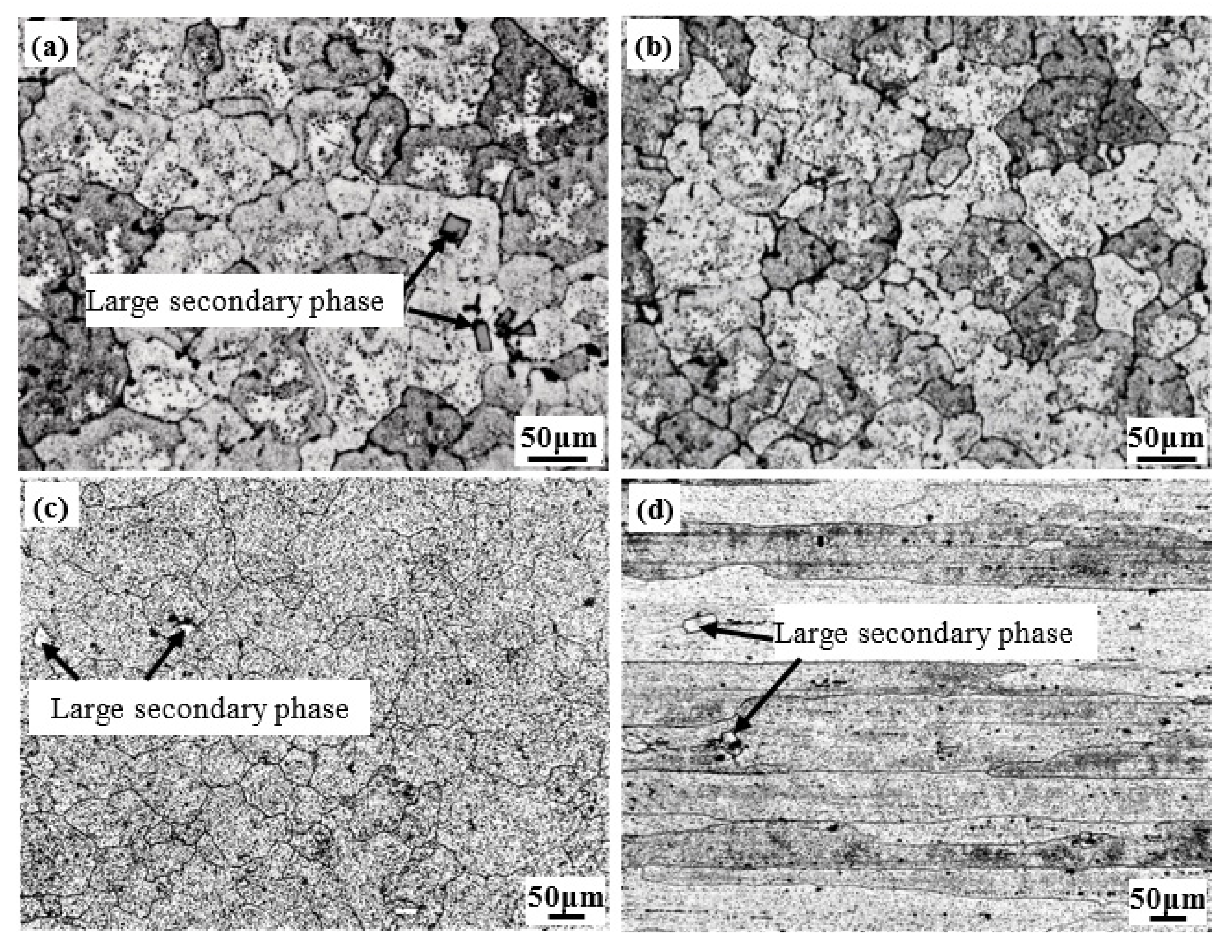

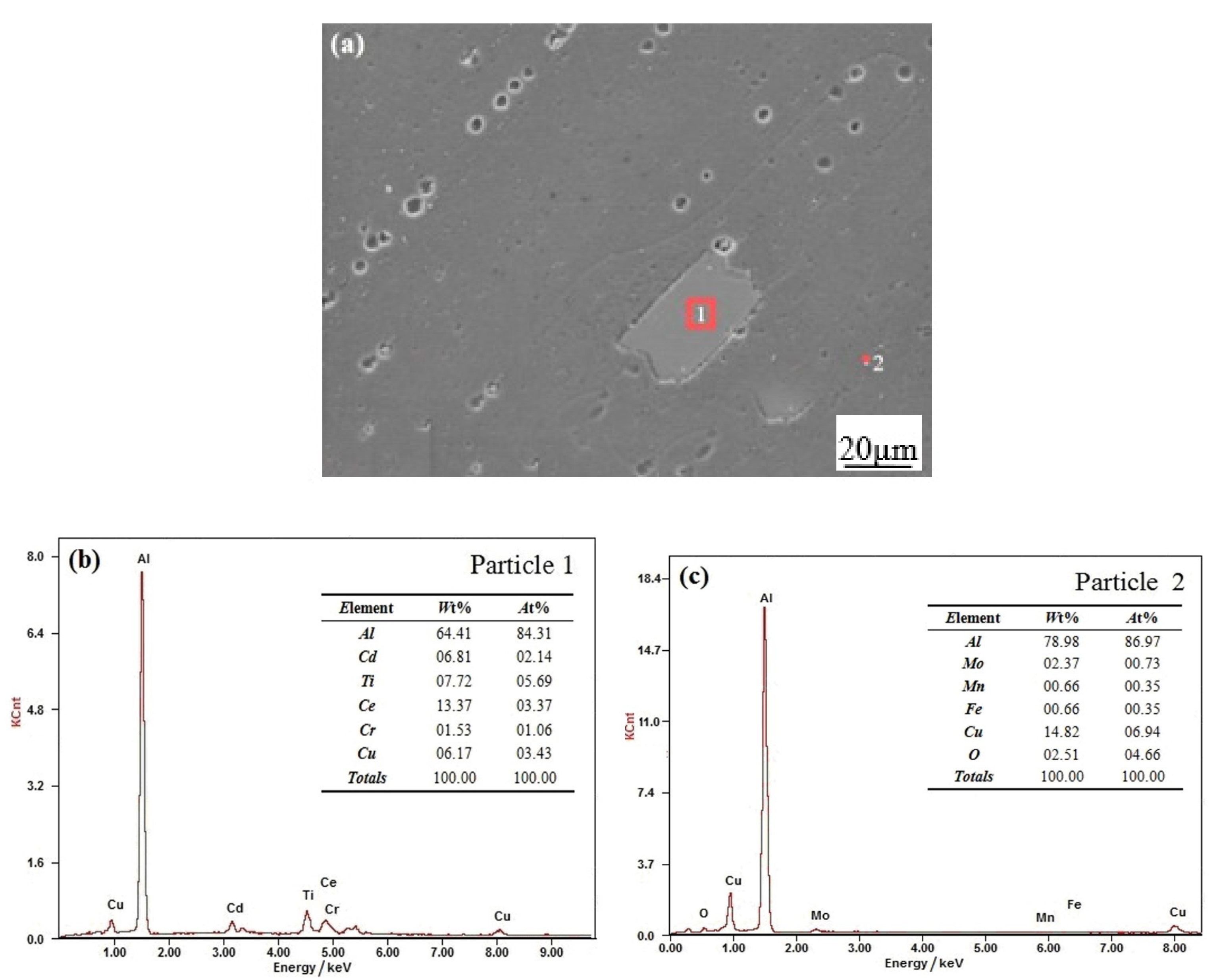


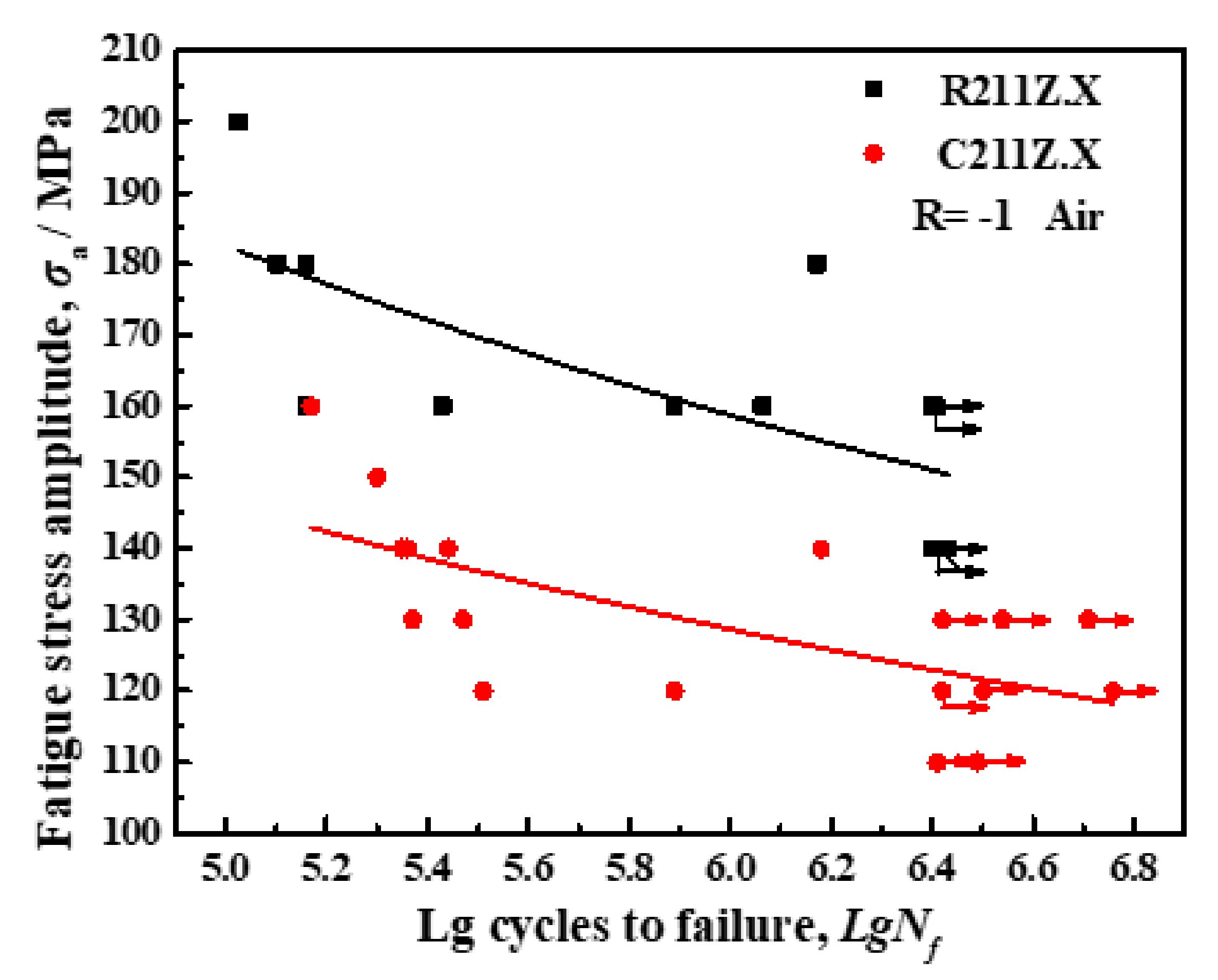
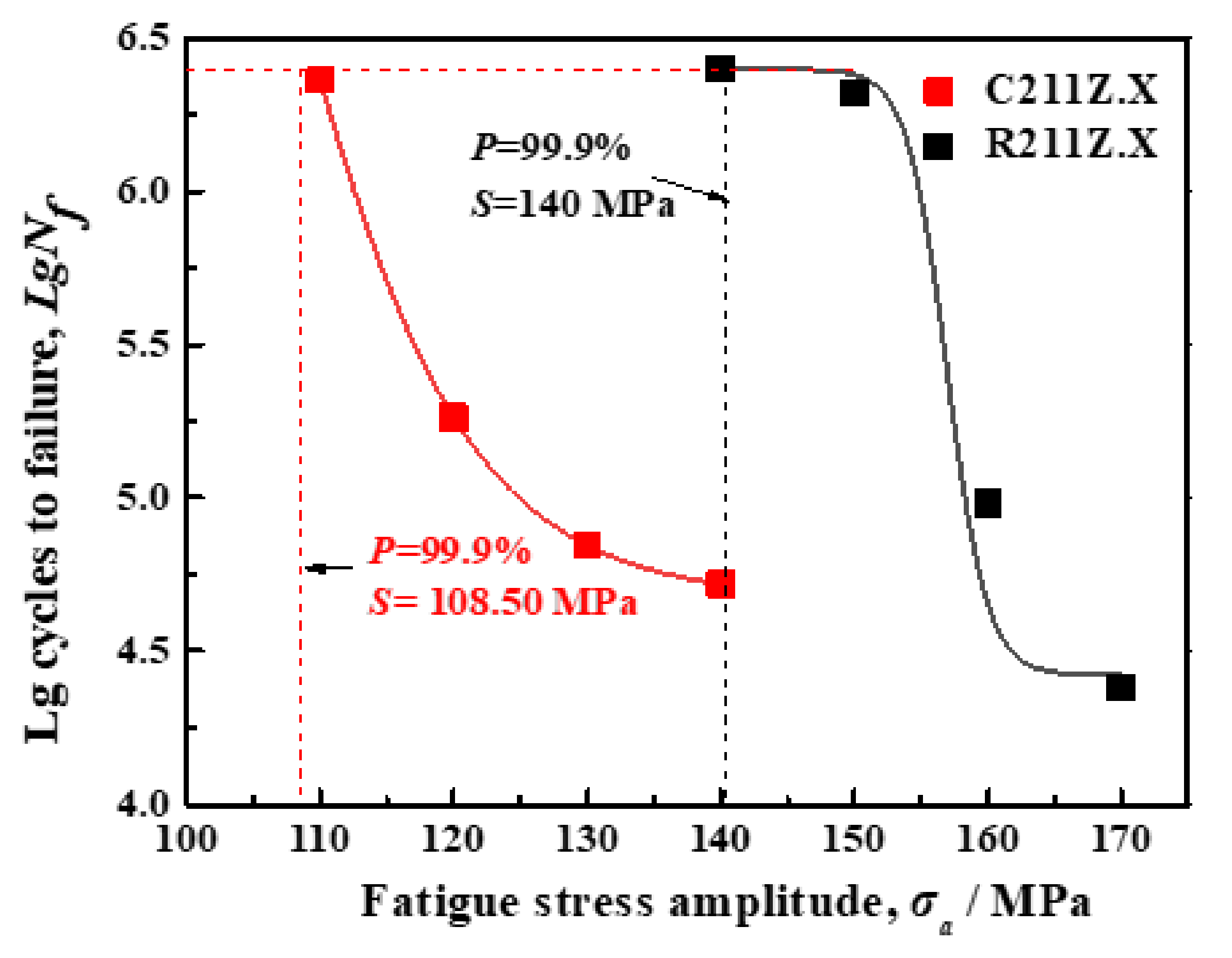

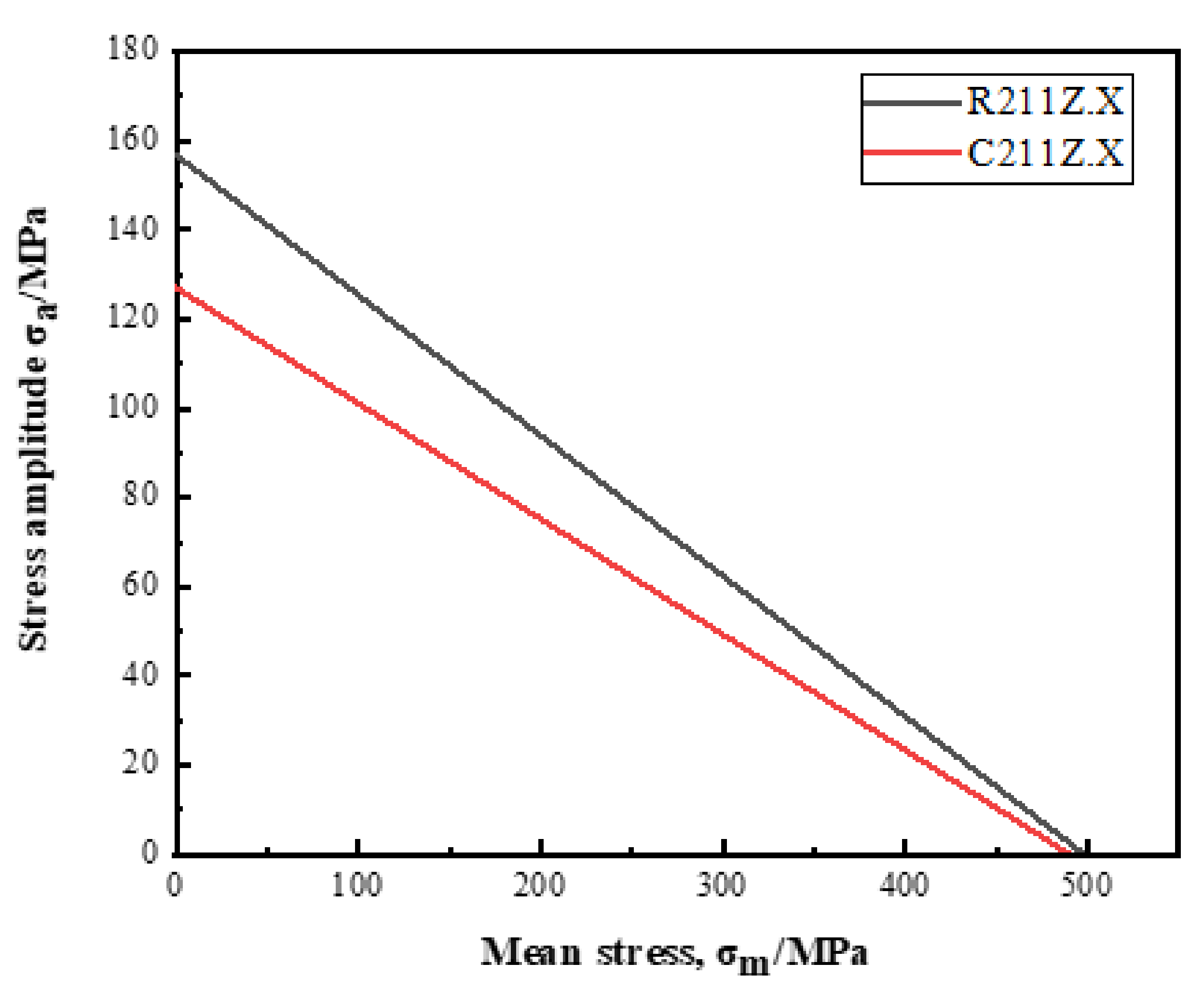
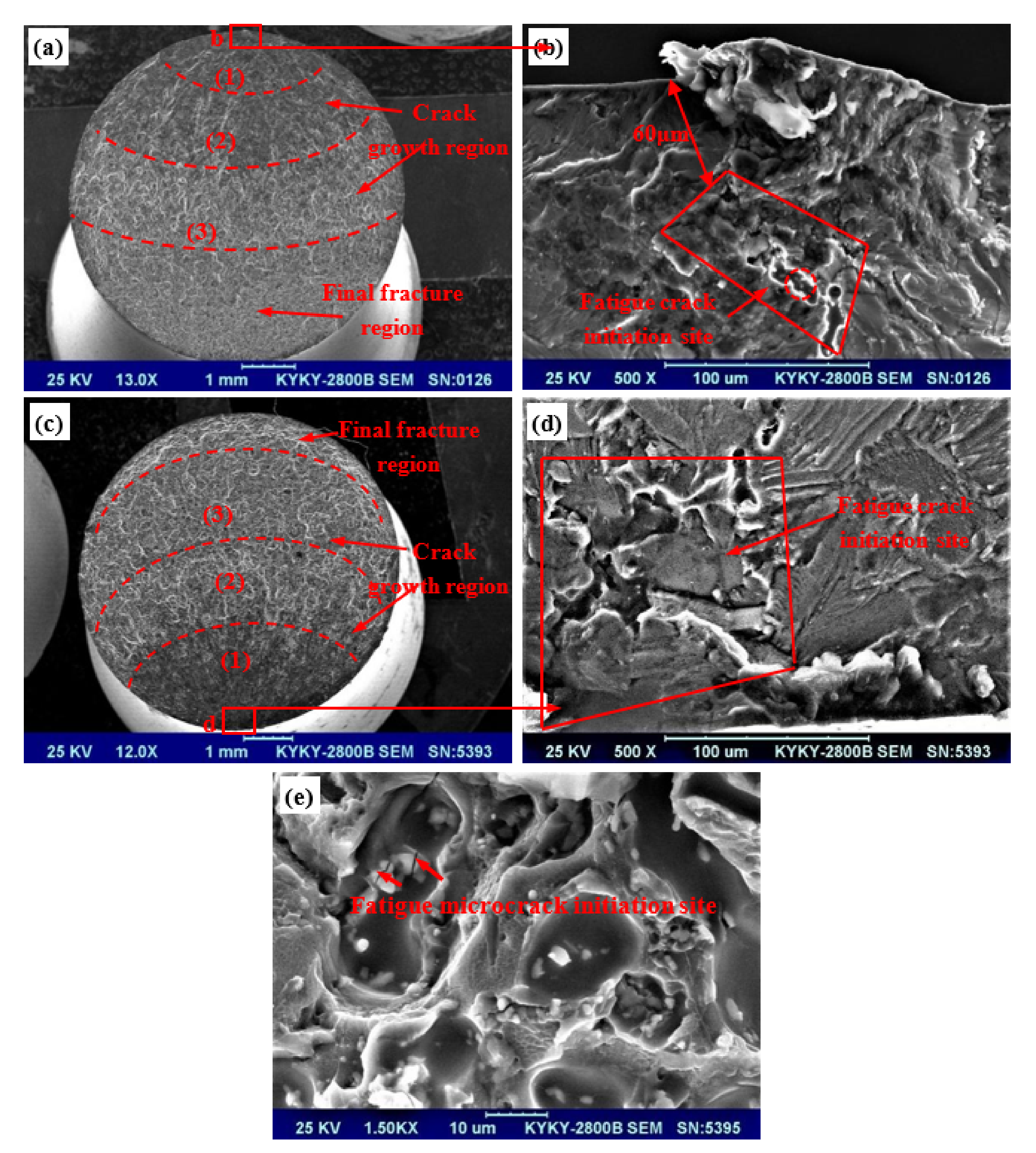
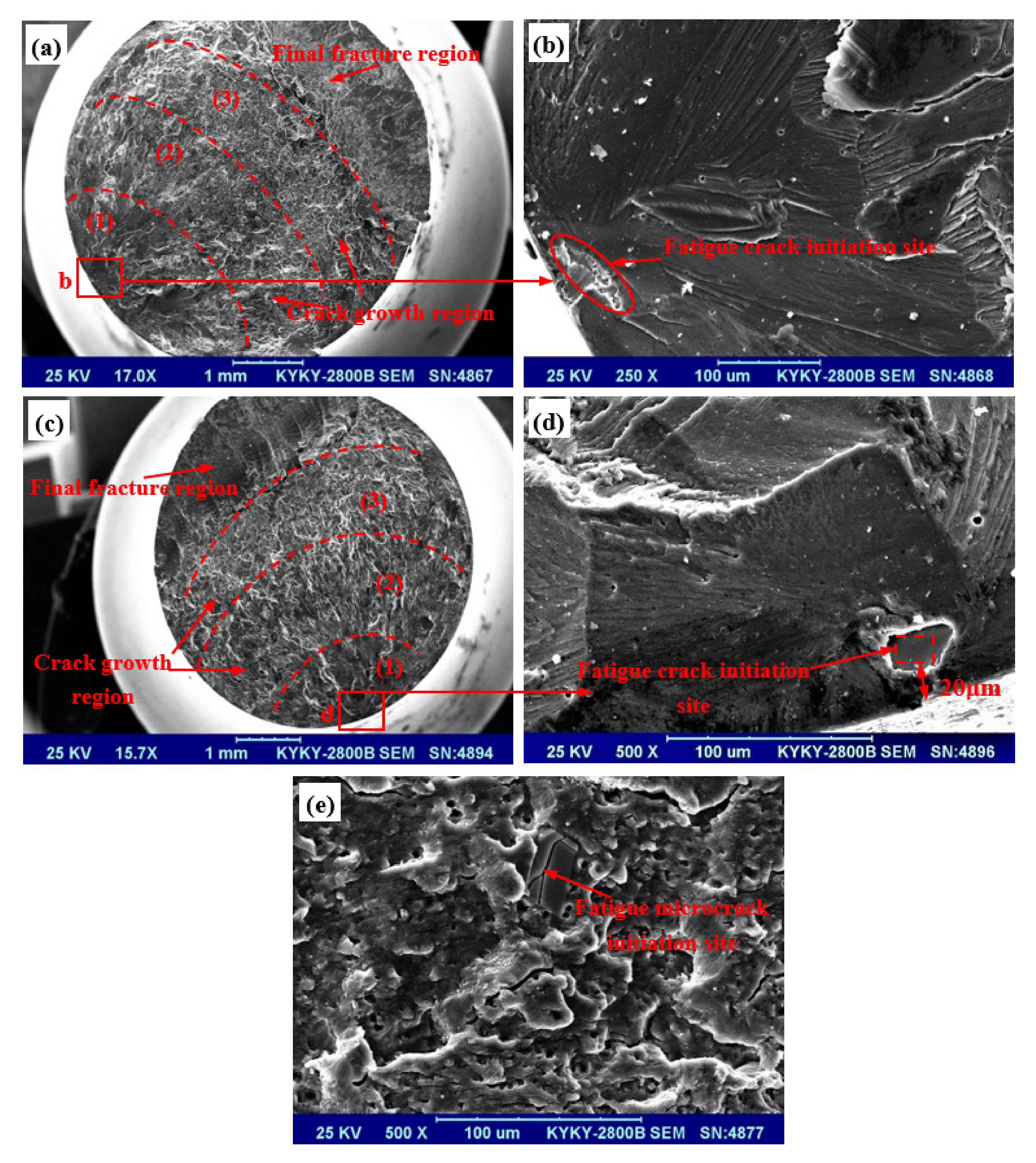

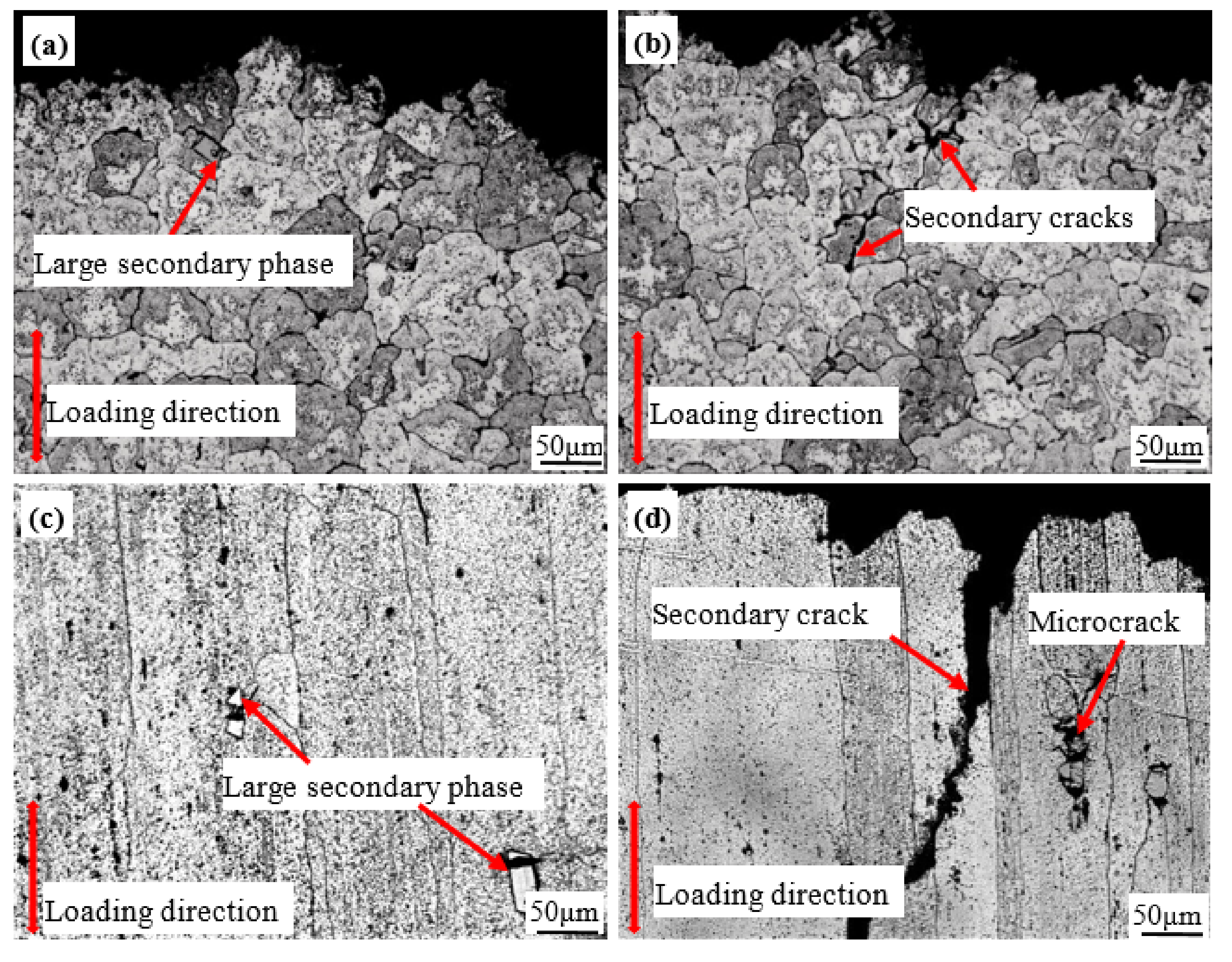




| Element | Cu | Mn | Ti | Zr | RE | Fe | Si | Mg | Al |
|---|---|---|---|---|---|---|---|---|---|
| Percent | 6.28 | 0.5 | 0.02 | 0.13 | 0.17 | 0.15 | 0.1 | 0.05 | Bal. |
| Alloy Condition | YS/MPa | UTS/MPa | El/% | RA/% | Hardness/HBW |
|---|---|---|---|---|---|
| C211Z.X | 393 ± 2 | 490 ± 3 | 12.93 ± 1 | 14.46 ± 1 | 124 ± 2 |
| R211Z.X | 432 ± 3 | 498 ± 2 | 10.42 ± 1 | 24.81 ± 1 | 165 ± 2 |
| C211Z.X Alloy | R211Z.X Alloy | |
|---|---|---|
| YS/MPa | 393 | 432 |
| UTS/MPa | 490 | 498 |
| σ−1(2.5×106)/MPa | 127.06 | 156.92 |
| σ−1(2.5×106,99.9%)/MPa | 108.50 | 140 |
| σ−1(2.5×106,50%)/MPa | 111.05 | 147.13 |
| σ−1(2.5×106)/YS | 0.323 | 0.363 |
| σ−1(2.5×106)/UTS | 0.259 | 0.315 |
| Element | wt.% | at.% |
|---|---|---|
| Al | 91.83 | 96.14 |
| Cu | 0.48 | 3.38 |
| Mn | 2.26 | 1.16 |
| Fe | 0.48 | 0.24 |
| Cr | 0.43 | 0.23 |
| Total | 100% | 100% |
| Element | wt.% | at.% |
|---|---|---|
| Al | 55.69 | 78.75 |
| Ti | 12.82 | 10.22 |
| Cu | 5.59 | 3.36 |
| Cd | 9.22 | 3.13 |
| Ce | 16.67 | 4.54 |
| Total | 100% | 100% |
Publisher’s Note: MDPI stays neutral with regard to jurisdictional claims in published maps and institutional affiliations. |
© 2022 by the authors. Licensee MDPI, Basel, Switzerland. This article is an open access article distributed under the terms and conditions of the Creative Commons Attribution (CC BY) license (https://creativecommons.org/licenses/by/4.0/).
Share and Cite
Zhang, Z.; Huang, C.; Chen, S.; Wan, M.; Yang, M.; Ji, S.; Zeng, W. Effect of Microstructure on High Cycle Fatigue Behavior of 211Z.X-T6 Aluminum Alloy. Metals 2022, 12, 387. https://doi.org/10.3390/met12030387
Zhang Z, Huang C, Chen S, Wan M, Yang M, Ji S, Zeng W. Effect of Microstructure on High Cycle Fatigue Behavior of 211Z.X-T6 Aluminum Alloy. Metals. 2022; 12(3):387. https://doi.org/10.3390/met12030387
Chicago/Turabian StyleZhang, Zhong, Chaowen Huang, Sinuo Chen, Mingpan Wan, Ming Yang, Shengli Ji, and Weidong Zeng. 2022. "Effect of Microstructure on High Cycle Fatigue Behavior of 211Z.X-T6 Aluminum Alloy" Metals 12, no. 3: 387. https://doi.org/10.3390/met12030387






